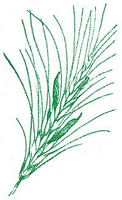skip
navigation  |
800-411-3222 (Español)
Rye as a Cover Crop |
| By Preston Sullivan NCAT Agriculture Specialist Published 2002 ATTRA Publication #CT168 |
The
printable PDF version of the entire document is available
at: http://attra.ncat.org/attra-pub/PDF/rye.pdf 2 pages — 117K Download Acrobat Reader |
Cereal rye is an excellent choice as a winter cover crop because it rapidly provides ground cover to hold the soil in place. It has deep roots that help prevent soil from becoming compacted in annually tilled fields. Rye’s extensive root system enables it to scavenge nutrients from the soil profile. In a no-till situation, it also can help control weeds.
Rye is one of the easiest crops to grow. Recommended seeding rates vary from 60 to 200 pounds per acre, depending on whom you ask. In the course of my research on cover crops in North Carolina and Virginia, I drilled rye at 90 pounds of seed per acre at 1 to 1½ inches deep and had excellent stands. The Virginia Extension Service recommends planting between two weeks before and four weeks after the first killing frost.
Rye, like wheat, will respond to nitrogen (N) fertilizer. When it follows corn and other crops fertilized with nitrogen, however, it seldom requires additional N. Rye has a good reputation for scavenging residual soil nitrogen when it follows other crops, and it is commonly grown for this purpose. Research indicates that rye can extract 40 to 80 pounds per acre of residual N. This reduces the potential for nitrate leaching into groundwater and conserves nitrogen fertilizer inputs. See the two enclosed articles about rye’s use as a nitrogen-scavenging catch crop. Medium soil-test levels of phosphorus and potassium will be adequate for rye grown as a cover crop.
Mowing or using a burn-down herbicide is an effective way of killing a rye cover crop so that no-till plantings of corn, soybeans, or another crop can be established. If mowing is the chosen method of killing the rye, do so at the flowering stage. At this stage, the anthers are extended, and pollen falls from the seed heads when shaken. If mowing is done earlier, the rye simply grows back. Rye provides better weed control when killed and left as a no-till mulch than when soil-incorporated. Natural plant chemicals that leach out of the rye mulch work to inhibit the germination of small-seeded weeds for about 30 days. When rye is left as a surface mulch, however, the option of killing escaped weeds by cultivation is largely precluded. A no-till cultivator still can be used, but it will disrupt the mulch cover, ending its contribution to weed suppression. North Carolina weed scientist Dr. Douglas Worsham concluded that not tilling plus using a mulch achieves the highest degree of weed control without using a pre-emergence herbicide. (Worsham, 1991) When the rye cover crop is incorporated into the soil, the field can be easily cultivated but the weed suppression provided by the rye will be largely gone. Of course, the rye holds the weeds back while it is growing, but cool-season weeds are usually not a problem in summer crops. The ATTRA publication Principles of Sustainable Weed Management contains more information on using rye as a weed suppressant and is available on the ATTRA Web site or by calling 800-346-9140. ReferenceWorsham, Douglas. 1991. Allelopathic cover crops to reduce herbicide input. p. 58-69. In: Proceedings of the Southern Weed Science Society. Volume 44. EnclosuresAnon. 1992. Seed rye with the combine? Ridge Till Hotline. August. p. 8. Davis, Susan. 1998. Rye cover cuts costs and increases yield. Soybean Digest. February. p. 38n, 38p. Helm, James L. and Al Schneiter. 1991. Rye Production and Utilization. North Dakota State University Extension Service, Fargo, ND. 4 p. Jost, Jerry. 1998. Rye. Sustainable Agriculture Management Guides, MG1K.1. Kansas Rural Center, Whiting, KS. 2 p. Lyman, Betsy and Marianne Sarrantonio. 1993. Cereal Rye. Soil Health Series: Northeast Cover Crop Fact Sheet #12. Rodale Institute Research Center, Kutztown, PA. 2 p. Marley, C.F. 1999. Cover crop bumps up soybean yields. Soybean Digest. February. p. S1. Rye as a Cover Crop
|
||||
|
Site Map | Comments | Disclaimer | Privacy Policy | Webmaster Copyright © NCAT 1997-2009. All Rights Reserved. |




